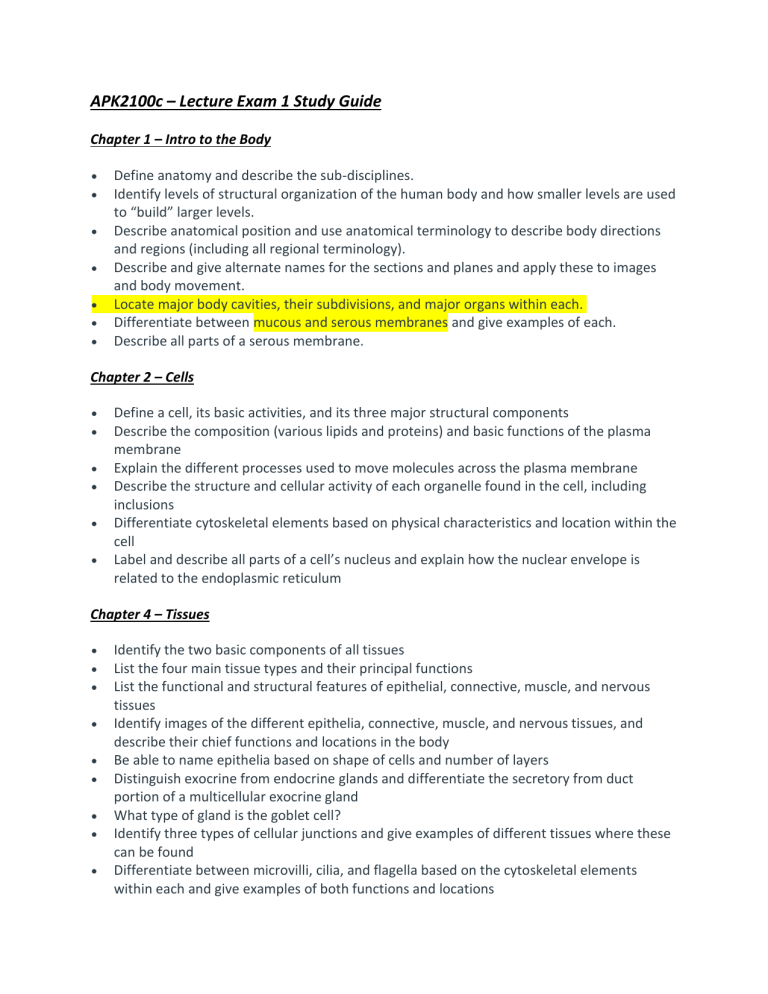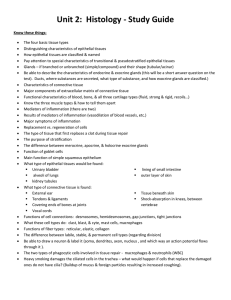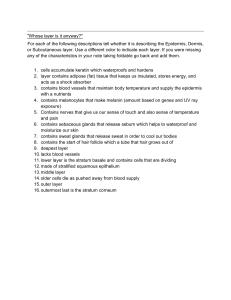
APK2100c – Lecture Exam 1 Study Guide Chapter 1 – Intro to the Body Define anatomy and describe the sub-disciplines. Identify levels of structural organization of the human body and how smaller levels are used to “build” larger levels. Describe anatomical position and use anatomical terminology to describe body directions and regions (including all regional terminology). Describe and give alternate names for the sections and planes and apply these to images and body movement. Locate major body cavities, their subdivisions, and major organs within each. Differentiate between mucous and serous membranes and give examples of each. Describe all parts of a serous membrane. Chapter 2 – Cells Define a cell, its basic activities, and its three major structural components Describe the composition (various lipids and proteins) and basic functions of the plasma membrane Explain the different processes used to move molecules across the plasma membrane Describe the structure and cellular activity of each organelle found in the cell, including inclusions Differentiate cytoskeletal elements based on physical characteristics and location within the cell Label and describe all parts of a cell’s nucleus and explain how the nuclear envelope is related to the endoplasmic reticulum Chapter 4 – Tissues Identify the two basic components of all tissues List the four main tissue types and their principal functions List the functional and structural features of epithelial, connective, muscle, and nervous tissues Identify images of the different epithelia, connective, muscle, and nervous tissues, and describe their chief functions and locations in the body Be able to name epithelia based on shape of cells and number of layers Distinguish exocrine from endocrine glands and differentiate the secretory from duct portion of a multicellular exocrine gland What type of gland is the goblet cell? Identify three types of cellular junctions and give examples of different tissues where these can be found Differentiate between microvilli, cilia, and flagella based on the cytoskeletal elements within each and give examples of both functions and locations Identify the four main classes of connective tissue and their common precursor tissue Describe the matrix of each connective tissue (types of cells as well as fibers in the ground substance) Compare the regenerative capacity of tissues Chapter 5- Integumentary Sys. Name the tissue types that compose the epidermis, dermis, hypodermis, and accessory organs. Be able to associate these tissues with organ function. Know the difference between thick and thin skin, including locations of each. Name and order the layers of the epidermis and dermis. Know the characteristics, types of cells, specific tissues, and relative proportions of the epidermis, dermis, and hypodermis. Relate these structures to functionality. Describe how the types of melanin contribute to diverse skin and hair colors and how melanin functions in cellular protection. Describe the structure of nails, hair, sebaceous glands, and sweat glands. Compare the structures and functions of eccrine sweat glands, apocrine sweat glands, and sebaceous glands. Explain how a knowledge of the structures of the integumentary system can be applied clinically (e.g., skin cancer) or to aspects of culture (e.g., tanning, tattooing).





